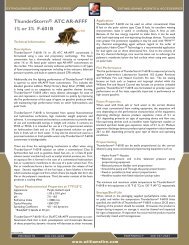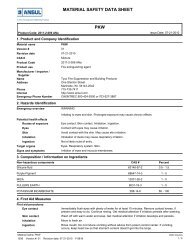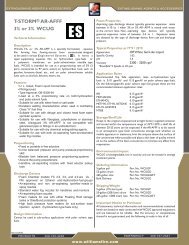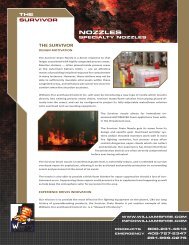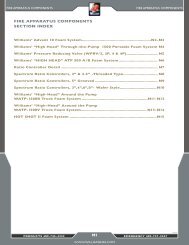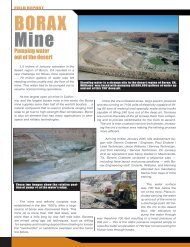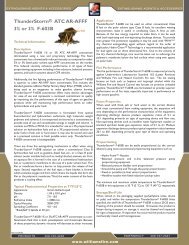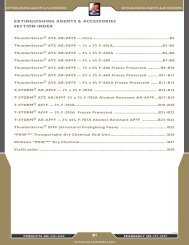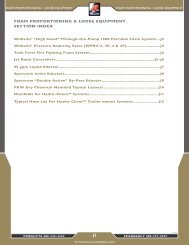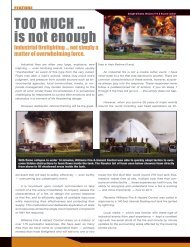Enbridge Case Study - Williams Fire & Hazard Control
Enbridge Case Study - Williams Fire & Hazard Control
Enbridge Case Study - Williams Fire & Hazard Control
- No tags were found...
Create successful ePaper yourself
Turn your PDF publications into a flip-book with our unique Google optimized e-Paper software.
FIELD REPORTFEATUREEdited by Brent GaspardLIGHTNING StrikesENBRIDGE Crude TankThunderStorm ® Strikes Back !Intermittent thunderstormson the morning ofSeptember 16, 2004 ledto a lightning strike to a 116foot floating roof crude tank.Captain Mike Meisenheimer,the first officer onsite at6:47 a.m., verified the strikeand a resulting 75% involvedseal fire to the roof ofthe crude oil tank. <strong>Fire</strong>Chief Dennis Fisher was notifiedat 6:55 a.m. of the situation— which resulted in aseal fire.All <strong>Enbridge</strong> site personnelare trained in fire extinguisheruse and fire emergency recognitionand response. Companysupervisors were quick to executeemergency response proceduresto establish an Incident CommandSystem (ICS), thereby managingthe initial response. Cushing <strong>Fire</strong>Department and Cushing PoliceDepartment personnel were the firstoutside agencies to arrive on thescene and they set about securingthe area and establishing a jointICS.Immediate concerns and effortsby facility personnel were to isolatethe area of the fire, and to determinerequirements for a proper responseto the emergency site. Secondaryconsideration was given to minimizingbusiness interruption.The Cushing <strong>Fire</strong> Department’sinitial response was a 1,250 gpmE-ONE pumper, and a 4,200 gallontanker. After initially sizing up thescene, <strong>Fire</strong> Department commandactivated a mutual aid response toLightning strike sets off seal fire on this 116 ft floatingroof crude tankthe Drumright and Chandler municipalfire departments. Using theSafety Alliance of Cushing (SAC)emergency call circle, an emergencyalert was issued to all neighboring oilcompanies.The Safety Alliance of Cushinghas a list of mutual aid respondersand available equipment, andthe call went out through the SACto Tulsa Sunoco Refinery for foamsupport. This call resulted in promptresponse by the Cushing Municipal<strong>Fire</strong> Department with its pre-plannedoil industry response equipment. Aidand assistance was also provided inthe form of a foam pumper and tankersupported by mutual aid from areafire departments.Employees onsite started lockout/tagoutprocedures to isolatepower to associated equipment andpossible secondary ignition sources,while an employee was assigned toopen the closest facility gate and directarriving emergency respondersas they arrived.Due to the rarity ofsuch events - and the thirstamongst Industrial <strong>Fire</strong>Responders for hands-onexperience, the turnout ofresponders from neighboringareas was overwhelming.Representatives fromseveral other local firedepartments includingthe Stroud, Glencoe, andStillwater <strong>Fire</strong> departmentswere on scene toassist the Cushing <strong>Fire</strong>Department.As mutual aid respondersarrived, full responseoperations were underwayby 9:15 a.m. Rapid response andcontainment procedures isolatedthe event to the initial tank strike. Noother structures were threatened andnormal operating processes continuedthroughout the rest of the facility.Dwight <strong>Williams</strong> meets with<strong>Enbridge</strong> officials to reviewresponse operationsInitial extinguishment efforts includedfolding water tanks and a watershuttle system to supply the useof hand lines for foam application.
FIELD REPORTMutual aid react teams movein to cool tank shell to preventreignition during Daspit flow toseal areaInitial operations were suspendedapproximately 80% into extinguishmentwhen equipment failure forcedthe response team to pull out of thetank roof area and reassess the situation.At this point, a joint decisionwas made to call in <strong>Williams</strong> <strong>Fire</strong>& <strong>Hazard</strong> <strong>Control</strong> for assistance.Chief Dennis Fisher called Dwight<strong>Williams</strong> at 10:30 a.m. to review thesituation …agreed to send 14 totes of foam insupport. The foam and the <strong>Williams</strong>team arrived in Cushing at about4:00 p.m. on the day of the strike.While waiting for the foam, localfirefighters established a water supplysystem utilizing a pond on thefacility. Two (2) 1,250 gpm and two(2) 1,000 gpm pumpers were usedto pump the water for a full-surfaceapplication.Extinguishment was achievedwith ThunderStorm® ATC 1x3 at1%. The fire was declared as extinguishedand loss stopped at 21:10p.m. by the Cushing <strong>Fire</strong> Chief.A rim-mount Daspit Tool is deployed for safe and effective reachto quickly extinguish seal fireSite analysis following the initialattack determined there was onlyabout 4 feet of product in the 60 foottall tank. The floating roof was nowstanding on its legs at approximately5 feet, creating a vapor space betweenthe roof and the surface ofcontained product. The decision wasmade to treat the situation as a fullsurface involvement.Following a discussion with the<strong>Enbridge</strong> officials, Dwight <strong>Williams</strong>and his crew agreed to deploy to thesite in Cushing as Joe Bennet, <strong>Fire</strong>Chief with Tulsa Sunoco Refinery,During a meeting betweenDwight <strong>Williams</strong>,Chief Fisher, and <strong>Enbridge</strong>representatives, Dwight proposeda unique approachfor this particular situation.“I’ve always wanted to pumpcrude oil back into a burning tank,but until now the right situation neverpresented itself.” <strong>Enbridge</strong> managementdecided to move forward withthis tactic. Oil was pumped backinto the tank at a calculated rate torefloat the lid and eliminate the vaporspace. As the lid was raised, anyinternal fire was extinguished andthe remaining seal fire could then besafely attacked using two (2) foamwands, and two (2) rim-mountedDaspit tools.This event proved the valueof establishing early ICS. With alarge number of responders and thescope of equipment and resourcesrequired for such an emergency itwas - and is - imperative to haveclear chain of command to best coordinateand protect those involvedin the response. The Safety Allianceof Cushing (SAC) was used in communications,safety and industrysupport during the operationIt was determined the right foam,water, and specialized equipmentdesigned to address such scenariosare vital resources when addressingfires of this type. Also, it is imperativethat joint response training beheld where mutual aid is requiredto respond to these concerns. A recentfield exercise by the FBI helpedmembers of the emergency responseteams and other companies cometogether in a more efficient manner.Joint training and exercises alwaysbenefit responders and improve thesituation in the time of an emergencythrough pre-planning. SAC plans tocontinue working with mutual aid departmentson unified command andadditional training toward ICS andcommunication preparedness to ensurefuture readiness.



